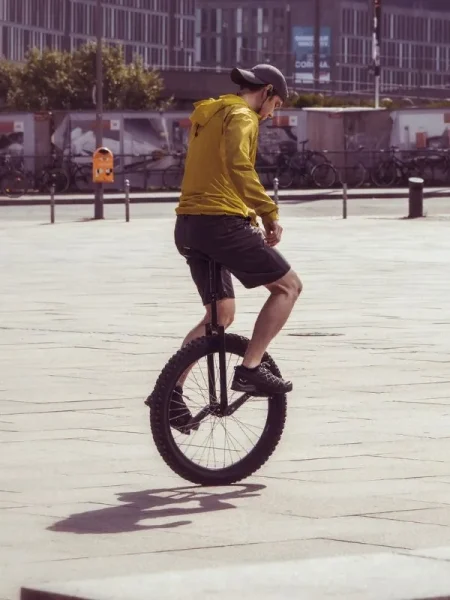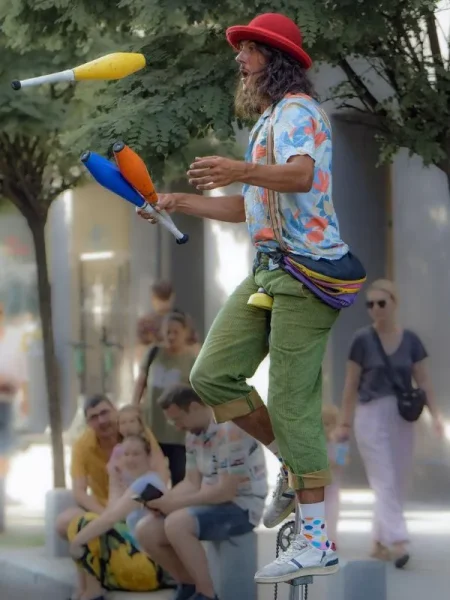Unicycle 101
Learn about unicycles, what they are, your first ride, different types, unicycling styles and more
What Is a Unicycle?
Okay, quick definition. A unicycle is a single-wheeled vehicle powered entirely by you. No gears. No brakes. No coasting. You pedal, you move. You stop pedaling, you stop. Simple on paper. Not so simple in practice.
Most unicycles have:
– One wheel (obviously)
– Cranks and pedals attached directly to the hub
– A saddle-style seat (more like a bike than a stool)
– No handlebars – your arms are your balance
At its core, it’s about balance, rhythm and trusting yourself to fall without panic. That last part? Kind of essential.
Let’s be honest – riding a unicycle seems kind of ridiculous at first. It looks hard. It is hard. One wheel? No handlebars? Most people wobble three feet and crash. But there’s something about it – something weirdly fascinating. And once you start learning, it hooks you.
If you’ve ever been curious about how people manage to balance on one wheel – or if you’re thinking of trying it yourself – this guide will
walk you through the basics. Simple language, real talk and just enough technical stuff to keep it useful.
Let’s roll.
Why Even Try to Ride a Unicycle?
Fair question.
There are easier hobbies. Ones that don’t require falling on your tailbone 47 times. But here’s the thing – once you get it, unicycling feels like flying. It’s smooth. Quiet. Meditative, even. Plus, it’s an incredible workout. Legs, core, posture, coordination… all working at once.
More reasons people get into unicycling:
– It’s weird – in a good way
– It’s portable (carry it like a backpack)
– Great conversation starter
– Builds confidence like nothing else
Also, it just looks cool. Not flashy, not loud. Cool in a quiet, rebellious way.
Unicycle Parts (Without Getting Too Nerdy)
Let’s break down the basic anatomy of a unicycle, because knowing your gear helps. Don’t worry – we’re skipping the engineering deep dive.
Wheel size matters. A lot.
– 20-inch: Most common for beginners. Agile, forgiving, easy to mount.
– 24-inch: Slightly faster, better for outdoor riding or light trails.
– 26-inch and up: Long-distance or mountain unicycling territory.
Then there’s the saddle – flat or curved. Some come with handle grips (useful when you start hopping or riding off-road).
Cranks: Short cranks = faster spins. Long cranks = more control. Most learners start with mid-length.
Pedals: Grippy ones help. Metal or plastic, but make sure they don’t shred your shins. (Pro tip: wear shin guards while learning.)
And finally: seat post and frame. Adjustable seat height is a must. Tall enough so your leg extends but still bends slightly – like a bike. Too high and you’ll fall. Too low and your knees will hate you.
The First Ride: What You Should Actually Expect
Spoiler: You won’t ride it right away. You’ll hold a wall, try to pedal and immediately tip over. That’s normal. Everyone looks like a confused baby giraffe on day one.
Here’s the starter plan:
– Find a support: A wall, fence, railing – something sturdy.
– Mount with one foot on a pedal: Push up, keep your body upright.
– Use your arms: For balance – not flailing, but reaching.
– Keep weight on the seat: Not your feet. This helps you stay stable.
– Look forward – not down: Yes, it’s terrifying. Yes, it helps.
Expect to practice 15–30 minutes at a time. Daily, if possible. Learning to unicycle is about muscle memory. You’ll feel silly for a while. Then one day, without warning, you’ll ride 10 feet – and that’s your moment.



Balance vs. Movement: The Mental Shift
Here’s a strange thing about unicycling – standing still is harder than moving.
Why? Because movement helps you balance. You correct your wobble while in motion. It’s like juggling. You can’t just freeze and hold the objects in place. You flow with them.
This is why beginners are told, “Just pedal.” Even if it feels chaotic. Pedaling keeps the wheel under you. It teaches your brain how to stay centered by adjusting constantly.
In a way, unicycling isn’t about balance – it’s about learning how to recover from losing balance.
Gear That Helps (And Stuff You Don’t Really Need)
You don’t need a garage full of equipment. But a few smart items make a huge difference:
– Helmet: No debate. Wear one.
– Wrist guards: Beginners fall forward a lot. Save your palms.
– Shin guards: Not required, but helpful if your pedals bite.
– Flat, open shoes: Skate shoes, tennis shoes – anything with a flat sole and grip.
You’ll see people wear elbow pads, knee pads, full armor. Up to you. If it makes you more confident, go for it. But most of the time, you’ll fall on your feet or land lightly on your side. It’s not like falling off a bike – you’re lower and usually moving slower.
Where Do People Even Ride These Things?
Once you’re up and riding, where do you actually go?
Turns out, unicycles work in more places than you’d expect:
– Sidewalks or parks: Smooth paths are ideal for practice.
– Indoor gyms or racquetball courts: Flat, open, non-distracting.
– Trails (yes, really): With the right unicycle, off-road riding is a thing.
– Urban exploring: Stairs, ramps, empty parking lots. Playgrounds for adults.
Some riders even commute by unicycle. Not kidding. There are long-distance touring unicycles with big 36-inch wheels. Google “unipacking” sometime – it’s wild.
When Falling Becomes Part of the Ride
Here’s the mental shift most people miss: Falling is fine.
It’s part of the process. The goal isn’t to avoid falling – it’s to fall safely and bounce back without fear. This teaches you how to bail out without panic. To land on your feet. To know where the edge is.
Most of the time, you’ll step off and laugh. Sometimes you’ll tumble. Rarely, you’ll crash hard – but by then, you’ll know how to brace and roll.
The real skill? Learning to trust your instincts while still having fun.
Styles of Unicycling (Yes, There’s More Than One)
Unicycling isn’t one-size-fits-all. Once you learn to ride, you can specialize – or not.
Some styles to check out:
– Freestyle: Think tricks, spins, choreography. Performed indoors, sometimes competitively.
– Muni (Mountain Unicycling): Off-road. Trails, roots, drops. Rugged frames, fat tires.
– Trials: Jumping between obstacles. Crazy technical.
– Street: Like BMX for unicycles. Rails, ledges, urban trick riding.
– Distance/Touring: Long rides on big wheels. Efficient, smooth, surprisingly fast.
– Clubs & Performance: Juggling, fire spinning, clowning, parades.
It’s not all circus and comedy anymore. There’s a serious, athletic side – and a playful, creative one too.
Real Talk: How Long Does It Really Take?
Here’s the truth. Most people take 10–15 hours of practice to ride 50 feet without falling. Not all at once. Spread out over a few weeks.
That’s shorter than learning guitar chords. Shorter than learning to snowboard. Way shorter than learning a language.
But yeah – those hours feel long. You’ll doubt yourself. You’ll laugh a lot. You’ll curse the wheel. And then – suddenly – you’ll be riding.
And after that? You’re not “learning to unicycle” anymore. You’re unicycling.
Final Thoughts: One Wheel Is Enough
So why do people stick with this strange little sport?
Because it’s satisfying. It’s not flashy or easy. It’s personal. Every ride is a quiet victory. Every wobble is a chance to learn. You don’t need speed, gears or a perfect path. Just balance, focus and the willingness to fall forward.
Unicycling is weird. But weird is good. Weird means you’re doing something most people won’t try. Something that takes guts, patience and just a little bit of madness.
So, if you’ve got a unicycle in your cart or in your garage collecting dust – grab it.
Lean forward.
Pedal.
And don’t forget to laugh when you fall.
